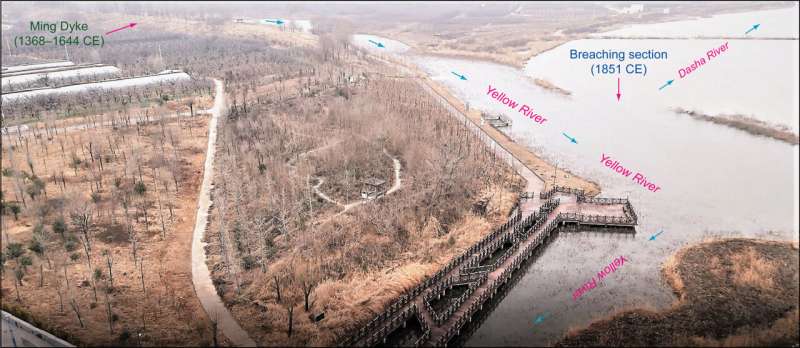February 24, 2023 report
This article has been reviewed according to Science X's editorial process and policies. Editors have highlighted the following attributes while ensuring the content's credibility:
fact-checked
peer-reviewed publication
trusted source
proofread
Study of Yellow River flooding over past 1,000 years shows human activities made flooding worse

A team of geologists, paleontologists and environmental scientists from Jiangsu Normal University and the Chinese Academy of Science, working with a colleague from Coastal Carolina University, has found that human attempts to keep the Yellow River in China from flooding over the past 1,000 years only made things worse.
In their paper published in the journal Science Advances, the group describes studying river sediments and historical records to learn more about the impact on the river by locals living in the area over the past millennium.
The Yellow River, the second-longest river in China, has played an important role in the history of that country. For thousands of years, people living near the river have used its fertile soil to grow food. But the population also had to contend with occasional flooding, which ruined crops and likely led to starvation for some. Over time, many of the locals began lining parts of the river with mud banks, hoping to keep the river from spilling out and onto crop lands. But such efforts, it turns out, tended to make things worse.
To learn more about the impact of mud-banking and other attempts to prevent flooding, such as channeling, the research team visited several sites along the river and collected sediment samples. They also collected flood records created over time by people living there. By analyzing both sources together, the group was able to create a detailed history of river flooding going back 1,000 years.
The researchers found that prior to humans altering the environment, the Yellow River tended to flood approximately four times every century. But just 6,000 years after humans established farming in the area, the river was flooding 10 times as often.
The researchers found that adding mudbanks next to the river led to an increase in sediment deposits, which lifted the river and made it overflow during heavy rains. They note that such flooding has finally been reduced in the modern era by removing mudbanks and increasing natural vegetation along the river, which helps to reduce the flow of soil into the river during the rainy season.
More information: Shi-Yong Yu et al, Human disturbances dominated the unprecedentedly high frequency of Yellow River flood over the last millennium, Science Advances (2023). DOI: 10.1126/sciadv.adf8576
Journal information: Science Advances
© 2023 Science X Network



















